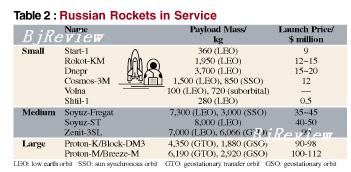|
competing on the international commercial launch market. Russia's commercial launch vehicles can reach most orbits, something that has made the country even more competitive internationally. (See Table 2 for their specifications and launch prices.)

Good record
Like the Proton, Russia's premier commercial launch vehicle, the Soyuz, which rose to fame for sending manned spacecraft and the Zenit-3SL launched from the sea, have also registered extraordinary performance. In 1996, the European-Russian company Starsem was created to provide commercial Soyuz launch services. To date, it has completed 18 commercial flights, all of which were successful-a remarkable record that attracts customers from across the world. With continued improvements, the latest version of the Soyuz can deliver a payload of 8 tons into the low-earth orbit.
The Zenit-3SL started to undertake commercial missions in 1999 and has had 24 commercial launches to date, 22 of which were successful, giving it a success rate of 91.7 percent. The launch vehicle has been jointly developed by Ukraine, Russia, the United States and Norway and is operated by Sea Launch Company LLC. The Yuzhnoye Design Office of Ukraine is responsible for its overall design and the design and manufacturing of its first and second stages. The S.P. Korolev Rocket and Space Corporation Energia of Russia are responsible for the design and manufacturing of its third stage. The Boeing Company of the United States is in charge of the design and manufacturing of the payload fairing and the rocket's marketing.
Small satellite launchers Dnepr, Rokot, Start, Shtil and Volna were converted from intercontinental ballistic missiles that went out of service after the Soviet Union and the United States signed the Strategic Arms Reduction Treaty in 1991. The Dnepr was adapted from the SS-18 intercontinental missile. It can be launched from the three silos in the Baikonur Cosmodrome and is operated by ISC Kosmotras, an international space transportation company established jointly by Russia and Ukraine in 1997. To date, the Dnepr has had 10 launches, one of which failed, a success rate of 90 percent. The Rokot is a three-stage small satellite launcher converted from the SS-19 missile by adding a Breeze-KM upper stage. It can deliver a payload of 1.9 tons into the low-earth orbit and can send two or more satellites in one flight. The Rokot can send satellites into the orbit quickly to replace retired ones. It is popular in the burgeoning markets of small satellite and satellite constellation launching services.
The Start is converted from the SS-25 missile by adding a fourth stage to the missile's first three stages. It is mainly used to deliver small satellites into the low-earth orbit. The Shtil and the Volna are derived from submarine-launched ballistic missiles and are used to place small payloads into the low-earth orbit. To date, the Shtil has had four commercial launches with one failure, whereas the Volna has only flown one commercial mission.
Bright prospects
In order to further reduce costs and meet clients' different needs, Russia started to develop the Angara rocket late last century. The Angara is designed to be modular. It will be able to deliver payloads into different orbits by using different configurations of the rocket core and booster stages. Angara's core is a two-stage rocket with a lifting capacity of 2 tons. To take on heavier payloads, one to four boosters can be strapped onto it. Each booster can increase the rocket's lifting capacity by 2 tons. In addition, two Angara rockets can be put together to become a large launch vehicle with a lifting capacity of 20 tons. At present, the Angara is still being developed and has yet to be made commercially available. It will be marketed by ILS.
In the past dozen years, Russia has stood out in the international commercial launch market with its sophisticated technology and successful business operations. It keeps improving its launch vehicles innovatively by enhancing their reliability, applicability and lifting capacity. It also is developing a new modular launch vehicle to shorten the cycle of rocket development, production and launch. These efforts have helped ensure Russia's leading status in space technology.
Russia's launch vehicles are well received by customers because of their low prices. Russia has expanded the market for its satellite launchers by creating joint-stock launch vehicle operators with other countries, especially European countries and the United States. It now holds about 50 percent of the international commercial launch market.
Russian commercial space launch companies have standardized their services. Apart from launch services, they provide customers with technical and personnel support and after-sale services. These services have not only generated profits for the companies, but also accelerated their shift to joint-stock entities. As the service system continues to improve, Russia's commercial space launch sector is poised to embrace an optimistic future.
The authors are engineers at the China Academy of Launch Vehicle Technology | 